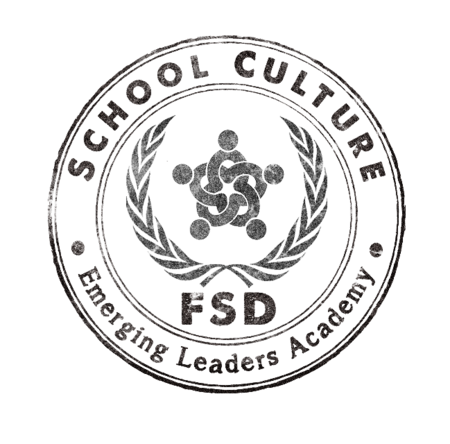FSD Emerging Leaders
Page Navigation
- Welcome to the Emerging Leaders Academy!
- CPSEL 1 - Development and Implementation of a Shared Vision
- CPSEL 2 - Instructional Leadership
- CPSEL 3 - Management and Learning Environment
- CPSEL 4 - Family and Community Engagement
- CPSEL 5 - Ethics and Integrity
- CPSEL 6 - External Context and Policy
- Emerging Leaders Academy Reflection
-
CPSEL 2 - Instructional Leadership
-
CPSEL 2: School Culture and Climate
Standard 2
Advocating, nurturing, and sustaining a school culture and instructional program conducive to student learning and staff professional growth.
-
- Shape a culture in which high expectations are the norm for each student as evident in rigorous academic work.
- Promote equity, fairness, and respect among all members of the school community.
- Facilitate the use of a variety of appropriate content-based learning materials and learning strategies that recognize students as active learners, value reflection and inquiry, emphasize the quality versus the amount of student application and performance, and utilize appropriate and effective technology.
- Guide and support the long-term professional development of all staff consistent with the ongoing effort to improve the learning of all students relative to the content standards.
- Provide opportunities for all members of the school community to develop and use skills in collaboration, distributed leadership, and shared responsibility.
- Create an accountability system grounded in standards-based teaching and learning.
- Utilize multiple assessments to evaluate student learning in an ongoing process focused on improving the academic performance of each student.

-
CPSEL 2: Standard, Elements, and Example Indicators
From the Commission on Teacher Credentialing, 2014
STANDARD 2: INSTRUCTIONAL LEADERSHIP
Education leaders shape a collaborative culture of teaching and learning informed by professional standards and focused on student and professional growth.Element 2A: Professional Learning Culture
Leaders promote a culture in which staff engages in individual and collective professional learning that results in their continuous improvement and high performance.
Example Indicators:
2A-1 Establish coherent, research-based professional learning aligned with organizational vision and goals for educator and student growth.
2A-2 Promote professional learning plans that focus on real situations and specific needs related to increasing the learning and well-being of all staff and students.
2A-3 Capitalize on the diverse experience and abilities of staff to plan, implement, and assess professional learning.
2A-4 Strengthen staff trust, shared responsibility, and leadership by instituting structures and processes that promote collaborative inquiry and problem solving.Element 2B: Curriculum and Instruction
Leaders guide and support the implementation of standards-based curriculum, instruction, and assessments that address student expectations and outcomes.
Example Indicators:
2B-1 Develop a shared understanding of adopted standards-based curriculum that reflects student content and performance expectations.
2B-2 Promote and monitor the use of state frameworks and guides that offer evidence-based instructional and support strategies to increase learning for diverse student assets and needs.
2B-3 Provide access to a variety of resources that are needed for the effective instruction and differentiated support of all students.
2B-4 Guide and monitor the alignment of curriculum, instruction, assessment, and professional practice.Element 2C: Assessment and Accountability
Leaders develop and use assessment and accountability systems to monitor, improve, and extend educator practice, program outcomes and student learning.
Example Indicators:
2C-1 Define clear purposes, goals, and working agreements for collecting and sharing information about professional practice and student outcomes.
2C-2 Guide staff and the community in regular disaggregation and analysis of local and state student assessment results and program data.
2C-3 Use information from a variety of sources to guide program and professional learning planning, implementation and revisions.
2C-4 Use professional expectations and standards to guide, monitor, support, and supervise to improve teaching and learning.
2C-5 Apply a variety of tools and technology to gather feedback, organize and analyze multiple data sources, and monitor student progress directed toward improving teaching and learning.Assignment: Videos of Examples and Non-Examples
Post a video to YouTube of examples and non-examples of what a new principal can do to create a positive environment in relation to staff culture, professional learning, curriculum, and school culture. The video should be between 3-5 minutes in length.
To post the video:
Go to YouTube.com
Click on the Sign in button in the top right corner
Sign in as fsdemergingleaders@myfsd.com
Password is fsdleaders12345
In the left side bar, click My Chanel
In the top right, click Upload
Proceed to uploading and follow directions. Save the link to you uploaded video and post it to the Discussion: Examples and Non-Examples.
In the Discussion section, leave constructive feedback for at least one other person's video.

